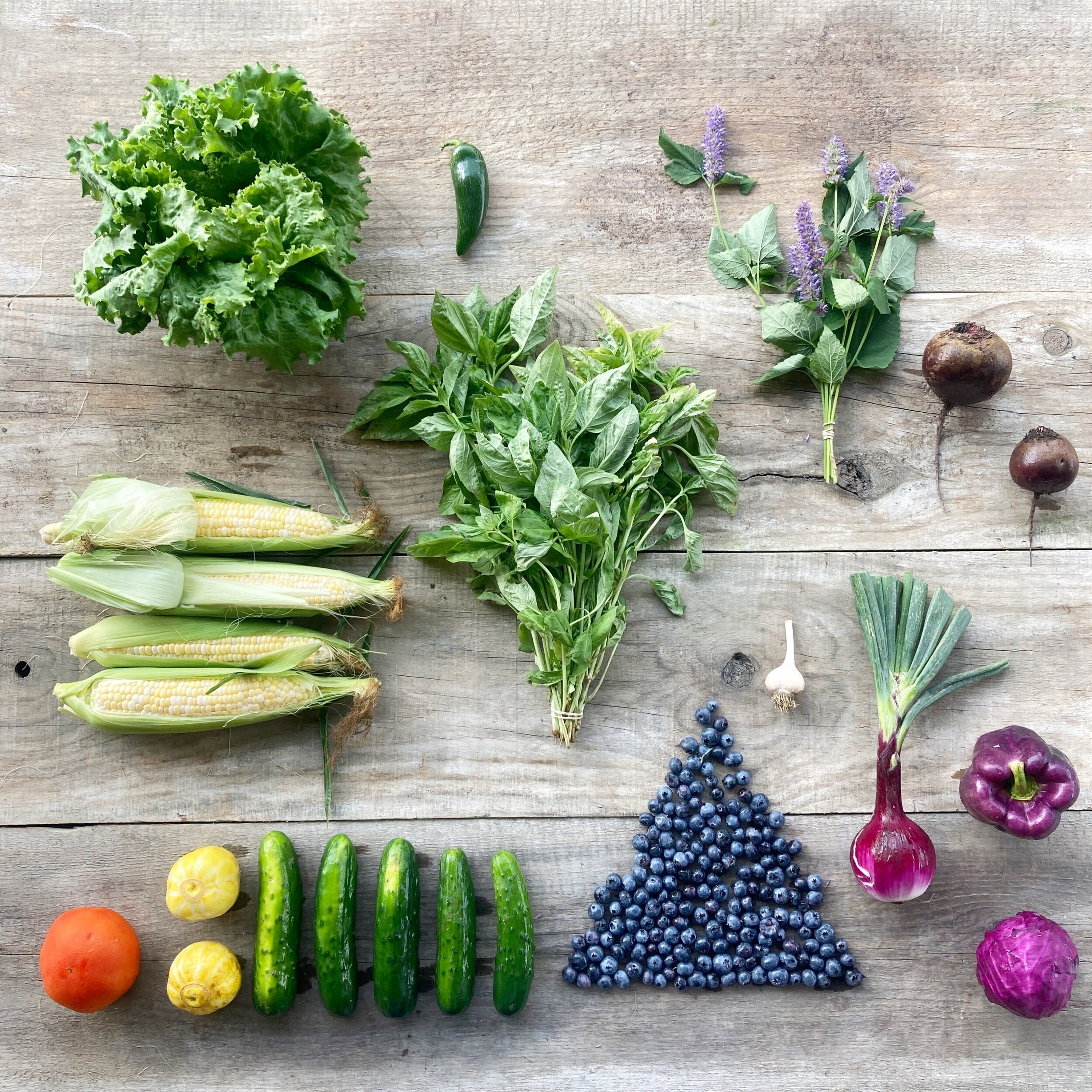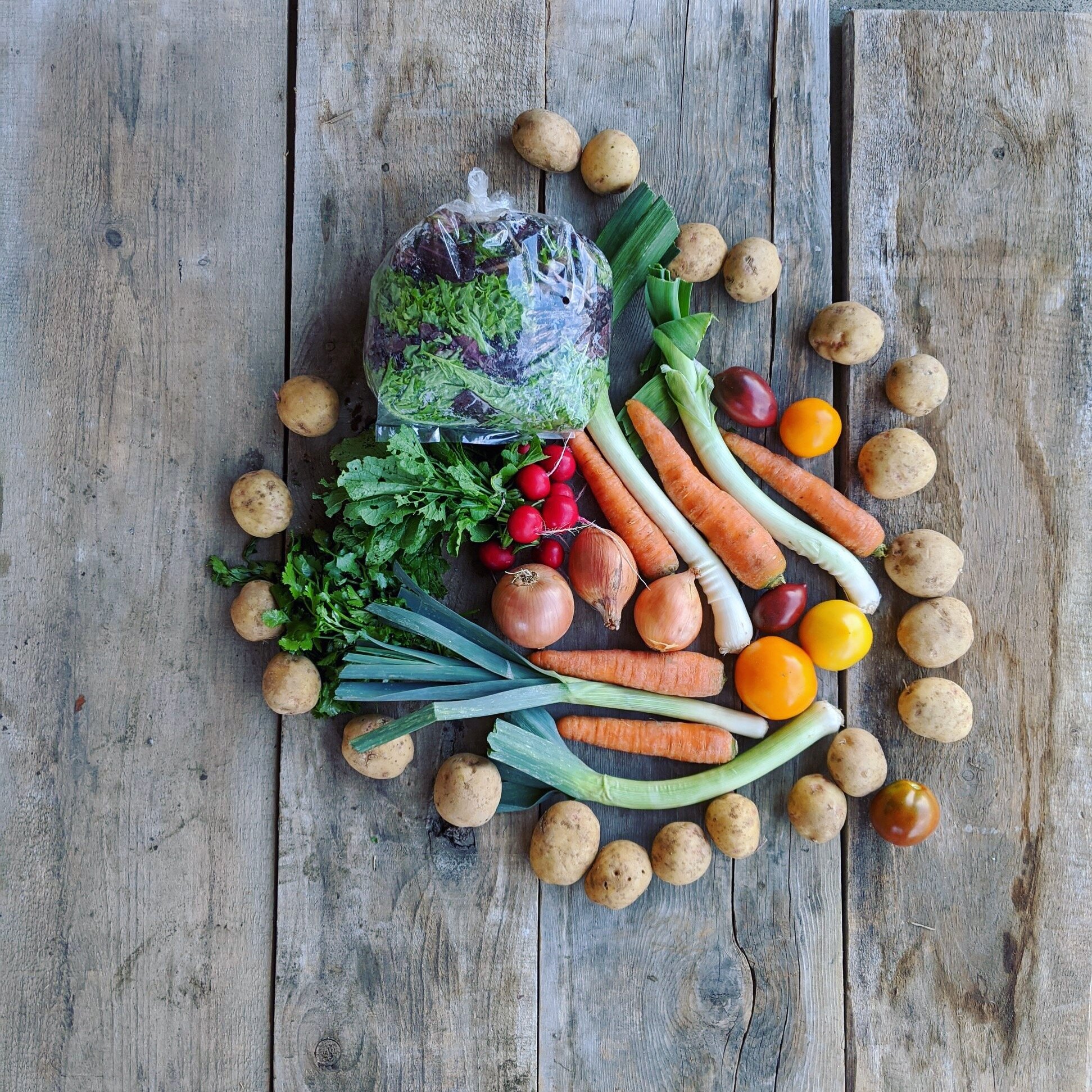P I C K L I S T
CORN - LETTUCE - PURPLE CABBAGE - BASIL - GARLIC - (softy) BLUEBERRIES - TOMATO - BEETS
LEMON CUKES - SLICING CUKES - ANNISE HYSSOP - PURPLE PEPPER - HOTTY PEP JALAPENO - RED ONION
Lengthy pro-tip section, so not a lot of room for updates but I can tell you this: My heart is totally bursting from the back to back blueberry-pick-pop-ups. It just feels so good to be able to welcome you all into the fields again! And the turn out for both days and the good vibes all around are really and truly what CSA dreams are made of. Well, that and a ½ bushel box full of kimchi making crops (napa cabbage/bok choy/ginger/hot pepper/scallions/etc… who’s with me on this?).
In other news, last week Mother Nature finally started to lighten up on us and now we are getting some proper summer weather. The cukes and summer and zucchini just started to really kick in. Melons are on the verge of major harvesting and the flavor has been pretty good considering the water and lack of sun. Cherry and grape tomatoes should be coming in to it pretty soon as well. We have made most of our final direct seedings outside with the exception of a few more radishes and a spinach seeding for fall. FALL!!! EGADS, NOT READY!! We continue to plant broccoli, cabbage and cauliflower in hopes of some favorable September/October conditions, but goodness gracious at this point it’s all a crapshoot.
PRO TIPS:
SOFTY BLUES… YES! YOUR BLUEBERRIES ARE QUITE SOFT! THIS IS NOT AN ILLUSION… Here is the deal, as blueberry season marches on, the picking conditions are less than ideal. Literal branches hanging out in standing water. The field we are currently on is soaked- therefor the berries are super soaked. Nobody is pumped, HOWEVER, these berries can be combined with your berries from PYO on Saturday and transformed into the most beautiful and flavorful smoothie/pie/jam/sauce etc… OR FREEZE these blues, and in the winter when you are desperate for some summertime flavorflavs, thaw out, combine with yogurt, and soft blueberries will never be more welcome.
JENNY’S NOTE: THE FOLLOWING IS ENTIRELY FROM THE BON APPETIT WEBSITE, BUT I WHOLE-HEARTEDLY AGREE WITH THE FOOD PROCESSOR SENTIMENT. IF YOU CAN FIGURE OUT AWAY TO GET ONE (THEY ARE SO EXPENSIVE I KNOW!!!) THEY ARE TOTALLY WORTH THE INVESTMENT. IT’S A SUMMER EATING SEASON MUST… You will need a food processor—if you don’t have one, we highly recommend making this an excuse to get one; it’s a good investment that you’ll use forever and ever and ever—and a handful of ingredients like basil, pine nuts, olive oil, Parmesan, garlic, and salt. The key for this classic pesto is to add the basil at the very end instead of blending everything all at once. That way the herbs will maintain their verdant color without bruising or losing flavor.
Ingredients
MAKES ABOUT 1½ CUPS
½ cup pine nuts
3 oz. Parmesan, grated (about ¾ cup)
2 garlic cloves, finely grated
6 cups basil leaves (about 3 bunches)
¾ cup extra-virgin olive oil
1 tsp. kosher salt
Step 1
Preheat oven to 350°. Toast pine nuts on a rimmed baking sheet (or quarter sheet pan), tossing once halfway through, until golden brown, 5–7 minutes. Transfer to a food processor and let cool. Add cheese and garlic and pulse until finely ground, about 1 minute. Add basil and place the top back on. With the motor running, add oil in a slow and steady stream until pesto is mostly smooth, with just a few flecks of green, about 1 minute. Season with salt.
Do Ahead: Pesto can be made 1 day ahead. Top with ½" oil to prevent browning. Store in a covered container (an extra drizzle of oil on top will help prevent oxidation) and chill.
Step 2
If you want to use this with pasta, cook 12 oz. dried pasta (we prefer long pasta for pesto) in a large pot of boiling salted water, stirring occasionally, until al dente. Drain, reserving ½ cup pasta cooking liquid.
Step 3
Place pesto and 2 Tbsp. unsalted butter, cut into pieces, in a large bowl. Add pasta and ¼ cup pasta cooking liquid. Using tongs, toss vigorously, adding more pasta cooking liquid if needed, until pasta is glossy and well coated with sauce. Season with salt.
Step 4
Divide pasta among bowls. Top with finely grated Parmesan.
Anise hyssop:
So fragrant! Bees love it! So beautiful! So productive! So medicinal! So delicious! The list goes on and on. This herb, with a flavor of licorice-mint, steeps beautifully in hot water for a divine summer tea meant to ward off the expected Summer cold, and soothe the ever racing Summer brain.
MEDICINAL PROPERTIES:
-alleviates fever and reduce bacterial and viral load in case of illness. Anti-inflammatory
- soothing cough suppressant
- encourages relaxation
How to use
Teas: Add fresh Anise Hyssop to a jar and cover with boiling water. Eyeball 6-8 tablespoons of fresh herb per quart jar (including flowers!). Cover and let steep until cool enough to drink. Strain and drink, or cool and refrigerate to save for iced tea.
Other: The leaves and flowers are edible. Add to savory or fruit salads, smoothies, or baking projects.
Garlic noodles (FROM THE OFFICIAL COOKBOOK OF SUMMER ‘21):
¼ cup canola oil
4 tblsp. minced garlic
¾ cup sliced red onion soaked in water and drained
2 tblsp. Soy sauce
½ cup sriracha
1 tblsp. Minced ginger
¼ teaspoon sugar
¼ teaspoon salt
2 tblsp. Water
12 ounces fresh wide wonton noodles or dried chinese wheat noodles
1 cucumber thinly sliced
3 green onions thinly sliced (sub in your onion tops!)
In a small pot, heat the oil over medium heat. Add 3 tablespoons of the garlic, set the heat to low, and fry, swirling the pot frequently, until the garlic is nearly golden in color, no more than 3 minutes. (If the garlic starts to darken too quickly, pull the pot off the heat for 30 seconds before returning it to the heat). Because the garlic can burn quickly, watch the pot the while time while the garlic fries.
Immediately pour the oil into a heatproof bowl and let it cool. The garlic will continue to cook and turn golden as it sits. If the garlic is already golden brown before you take it off the heat and it looks like it might burn if left in the oil, all is not lost. Pour the oil through a fine mesh strainer into a heatproof bowl to remove the garlic from the oil and stop it from cooking further. Once the oil has cooled a bit, return the garlic to the oil.
Add the onions and soy sauce to the garlic.
In a small serving bowl, stir together the sriracha, the remaining 1 tablespoon of garlic, the ginger, sugar, salt, and water.
Bring a pot of water to a boil. Add the noodles and cook, stirring often with chopsticks, until nearly soft all the way through, about 4 minutes or until tender but still slightly chewy. Drain in a colander and rinse briefly under cold water. Give the colander a shake to remove excess water.
Return noodles to the pot. Pour in the garlic-soy sauce mixture and add the cucumbers. Give the noodles a stir with a pair of tongs, then divide among bowls. Top with “green onions”. Serve with srircha
























